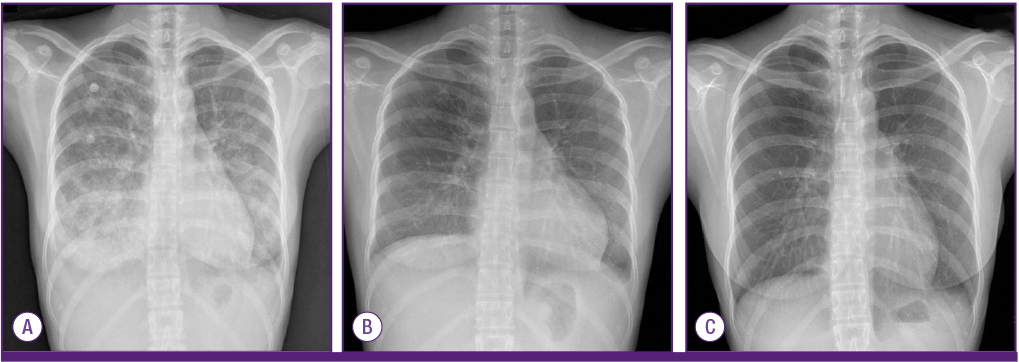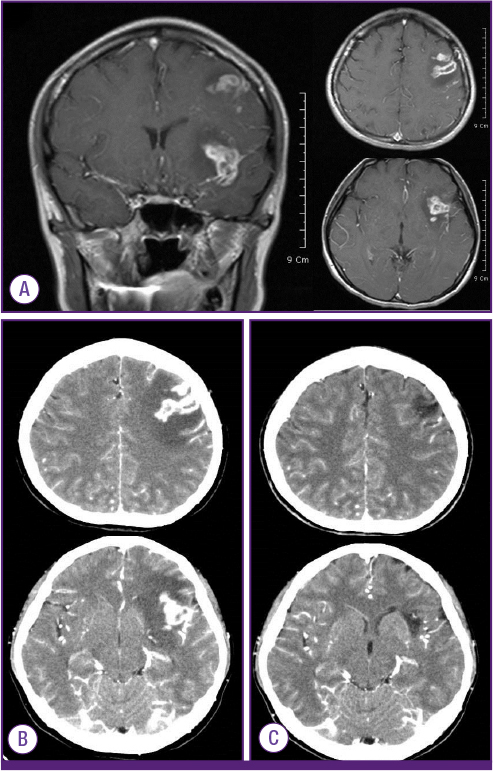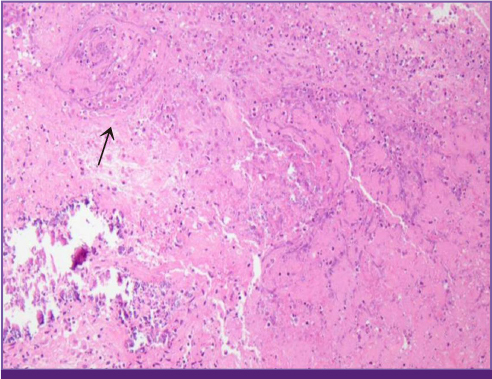Infect Chemother.
2016 Mar;48(1):41-46. 10.3947/ic.2016.48.1.41.
A Case of Disseminated Multidrug-Resistant Tuberculosis involving the Brain
- Affiliations
-
- 1Department of Internal Medicine, Ewha Womans University School of Medicine, Seoul, Korea. heechoi@ewha.ac.kr
- 2Department of Neurological Surgery, Ewha Womans University School of Medicine, Seoul, Korea.
- 3Department of Pathology, Ewha Womans University School of Medicine, Seoul, Korea.
- KMID: 2170516
- DOI: http://doi.org/10.3947/ic.2016.48.1.41
Abstract
- We report a case of a 23-year-old female immigrant from China who was diagnosed with multidrug-resistant tuberculosis affecting her lung and brain, resistant to the standard first-line therapeutics and streptomycin. She was treated with prothionamide, moxifloxacin, cycloserine, and kanamycin. However, her headache and brain lesion worsened. After the brain biopsy, the patient was confirmed with intracranial tuberculoma. Linezolid was added to intensify the treatment regimen, and steroid was added for the possibility of paradoxical response. Kanamycin was discontinued 6 months after initiation of the treatment; she was treated for 18 months with susceptible drugs and completely recovered. To our knowledge, this case is the first multidrug-resistant tuberculosis that disseminated to the brain in Korea.
Keyword
MeSH Terms
-
Biopsy
Brain*
China
Cycloserine
Emigrants and Immigrants
Female
Headache
Humans
Kanamycin
Korea
Linezolid
Lung
Mycobacterium tuberculosis
Prothionamide
Streptomycin
Tuberculoma, Intracranial
Tuberculosis, Central Nervous System
Tuberculosis, Multidrug-Resistant*
Tuberculosis, Pulmonary
Young Adult
Cycloserine
Kanamycin
Prothionamide
Streptomycin
Figure
Cited by 2 articles
-
Multiresistant Tuberculosis and Its Paradoxical Manifestations
José Luis Soto-Hernández
Infect Chemother. 2016;48(3):225-226. doi: 10.3947/ic.2016.48.3.225.Reply: Multiresistant Tuberculosis and Its Paradoxical Manifestations
Hee Jung Choi
Infect Chemother. 2016;48(3):227-228. doi: 10.3947/ic.2016.48.3.227.
Reference
-
1. Joint Committee for the Development of Korean Guidelines for Tuberculosis, and Korea Centers for Disease Control & Prevention. Korean Guidelines for Tuberculosis. 1st ed.2011. Accessed 10 July 2014. http://www.lungkorea.org/thesis/guide.php.2. World Health Organization (WHO). Guidelines for the programmatic management of drug-resistant tuberculosis. 2011. Accessed 10 July 2014. Available at: http://www.lungkorea.org/thesis/guide.php.3. Korea Centers for Disease Control and Prevention (KCDC). Annual report on the notified tuberculosis in Korea, 2012. Accessed 10 July 2014. Available at: http://www.cdc.go.kr/CDC/info/CdcKrInfo1001.jsp?menuIds=HOME001-MNU1155-MNU1083-MNU1375-MNU1084.4. Mitchison DA. Drug resistance in tuberculosis. Eur Respir J. 2005; 25:376–379.
Article5. Lacoma A, Garcia-Sierra N, Prat C, Ruiz-Manzano J, Haba L, Rosés S, Maldonado J, Domínguez J. GenoType MTB-DRplus assay for molecular detection of rifampin and isoniazid resistance in Mycobacterium tuberculosis strains and clinical samples. J Clin Microbiol. 2008; 46:3660–3667.
Article6. World Health Organization (WHO). Global tuberculosis report, 2013. Accessed 10 July 2014. Available at: http://www.who.int/tb/publications/global_report/en.7. Korea Centers for Disease Control and Prevention (KCDC). Current situation of MDR-TB and XDR-TB in Korea, 2009. Accessed 10 July 2014. Aveilable at: http://www.cdc.go.kr/CDC/contents/CdcK-rContentLink.jsp?fid=31&cid=12386&ctype=6.8. Lee WY, Ling M, Anderson G, Achawal S, Thaker HK. Isoniazid-resistant intracranial tuberculoma treated with a combination of moxifloxacin and first-line anti-tuberculosis medication. J Med Microbiol. 2011; 60:1550–1552.
Article9. Lee M, Lee J, Carroll MW, Choi H, Min S, Song T, Via LE, Goldfeder LC, Kang E, Jin B, Park H, Kwak H, Kim H, Jeon HS, Jeong I, Joh JS, Chen RY, Olivier KN, Shaw PA, Follmann D, Song SD, Lee JK, Lee D, Kim CT, Dartois V, Park SK, Cho SN, Barry CE 3rd. Linezolid for treatment of chronic extensively drug-resistant tuberculosis. N Engl J Med. 2012; 367:1508–1518.
Article10. Chang KC, Yew WW, Tam CM, Leung CC. WHO group 5 drugs and difficult multidrug-resistant tuberculosis: a systematic review with cohort analysis and meta-analysis. Antimicrob Agents Chemother. 2013; 57:4097–4104.
Article11. Ntziora F, Falagas ME. Linezolid for the treatment of patients with central nervous system infection. Ann Pharmacother. 2007; 41:296–308.
Article12. Malacarne P, Viaggi B, DI Paolo A, Danesi R, Del Tacca M. Linezolid cerebrospinal fluid concentration in central nervous system infection. J Chemother. 2007; 19:90–93.
Article13. Schecter GF, Scott C, True L, Raftery A, Flood A, Mase S. Linezolid in the treatment of multidrug-resistant tuberculosis. Clin Infect Dis. 2010; 50:49–55.
Article14. Hawkey CR, Yap T, Pereira J, Moore DA, Davidson RN, Pasvol G, Kon OM, Wall RA, Wilkinson RJ. Characterization and management of paradoxical upgrading reactions in HIV-uninfected patients with lymph node tuberculosis. Clin Infect Dis. 2005; 40:1368–1371.
Article15. Joseph P, Desai VB, Mohan NS, Fredrick JS, Ramachandran R, Raman B, Wares F, Ramachandran R, Thomas A. Outcome of standardized treatment for patients with MDR-TB from Tamil Nadu, India. Indian J Med Res. 2011; 133:529–534.16. Kent SJ, Crowe SM, Yung A, Lucas CR, Mijch AM. Tuberculous meningitis: a 30-year review. Clin Infect Dis. 1993; 17:987–994.
Article17. Goble M, Iseman MD, Madsen LA, Waite D, Ackerson L, Horsburgh CR Jr. Treatment of 171 patients with pulmonary tuberculosis resistant to isoniazid and rifampin. N Engl J Med. 1993; 328:527–532.
Article18. Vinnard C, Winston CA, Wileyto EP, MacGregor RR, Bisson GP. Multidrug resistant tuberculous meningitis in the United States, 1993-2005. J Infect. 2011; 63:240–242.
Article19. Patel VB, Padayatchi N, Bhigjee AI, Allen J, Bhagwan B, Moodley AA, Mthiyane T. Multidrug-resistant tuberculous meningitis in Kwazulu-Natal, South Africa. Clin Infect Dis. 2004; 38:851–856.
Article
- Full Text Links
- Actions
-
Cited
- CITED
-
- Close
- Share
- Similar articles
-
- Multidrug-resistant Tuberculosis Spondylitis: A Case Report
- Differentiating between Intestinal Tuberculosis and Crohn’s Disease May Be Complicated by Multidrug-resistant Mycobacterium tuberculosis
- The survey for clinical course of intractable pulmonary tuberculosis
- Multidrug-resistant Tuberculosis
- Risk Factors for Primary Multidrug Resistant Tuberculosis






